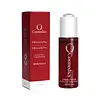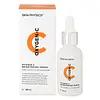What's inside
What's inside
 Key Ingredients
Key Ingredients

 Benefits
Benefits

 Ingredients Side-by-side
Ingredients Side-by-side

Water
Skin ConditioningNiacinamide
SmoothingSodium Ascorbyl Phosphate
AntioxidantTripeptide-10 Citrulline
Skin ConditioningOligopeptide-68
BleachingPseudoalteromonas Ferment Extract
HumectantHydrolyzed Soy Protein
HumectantTripeptide-1
Skin ConditioningHydrolyzed Wheat Protein
Skin ConditioningLecithin
EmollientButylene Glycol
HumectantSodium Oleate
CleansingXanthan Gum
EmulsifyingCarbomer
Emulsion StabilisingDisodium EDTA
Caprylyl Glycol
EmollientPhenoxyethanol
PreservativeWater, Niacinamide, Sodium Ascorbyl Phosphate, Tripeptide-10 Citrulline, Oligopeptide-68, Pseudoalteromonas Ferment Extract, Hydrolyzed Soy Protein, Tripeptide-1, Hydrolyzed Wheat Protein, Lecithin, Butylene Glycol, Sodium Oleate, Xanthan Gum, Carbomer, Disodium EDTA, Caprylyl Glycol, Phenoxyethanol
Water
Skin ConditioningSodium Ascorbyl Phosphate
AntioxidantGlycerin
HumectantNiacinamide
SmoothingTerminalia Ferdinandiana Fruit Extract
AntioxidantSodium Hyaluronate
HumectantEthylhexylglycerin
Skin ConditioningMagnesium Aspartate
Skin ConditioningZinc Gluconate
Skin ConditioningPentylene Glycol
Skin ConditioningRosmarinus Officinalis Leaf Extract
AntimicrobialCopper Gluconate
Skin ConditioningCitric Acid
BufferingGlucose
HumectantBioflavonoids
Skin ConditioningChlorogenic Acids
AntioxidantPhenoxyethanol
PreservativeWater, Sodium Ascorbyl Phosphate, Glycerin, Niacinamide, Terminalia Ferdinandiana Fruit Extract, Sodium Hyaluronate, Ethylhexylglycerin, Magnesium Aspartate, Zinc Gluconate, Pentylene Glycol, Rosmarinus Officinalis Leaf Extract, Copper Gluconate, Citric Acid, Glucose, Bioflavonoids, Chlorogenic Acids, Phenoxyethanol
 Reviews
Reviews

Ingredients Explained
These ingredients are found in both products.
Ingredients higher up in an ingredient list are typically present in a larger amount.
Niacinamide is a multitasking form of vitamin B3 that strengthens the skin barrier, reduces pores and dark spots, regulates oil, and improves signs of aging.
And the best part? It's gentle and well-tolerated by most skin types, including sensitive and reactive skin.
You might have heard of "niacin flush", or the reddening of skin that causes itchiness. Niacinamide has not been found to cause this.
In very rare cases, some individuals may not be able to tolerate niacinamide at all or experience an allergic reaction to it.
If you are experiencing flaking, irritation, and dryness with this ingredient, be sure to double check all your products as this ingredient can be found in all categories of skincare.
When incorporating niacinamide into your routine, look out for concentration amounts. Typically, 5% niacinamide provides benefits such as fading dark spots. However, if you have sensitive skin, it is better to begin with a smaller concentration.
When you apply niacinamide to your skin, your body converts it into nicotinamide adenine dinucleotide (NAD). NAD is an essential coenzyme that is already found in your cells as "fuel" and powers countless biological processes.
In your skin, NAD helps repair cell damage, produce new healthy cells, support collagen production, strengthen the skin barrier, and fight environmental stressors (like UV and pollution).
Our natural NAD levels start to decline with age, leading to slower skin repair, visible aging, and a weaker skin barrier. By providing your skin niacinamide, you're recharging your skin's NAD levels. This leads to stronger, healthier, and younger looking skin.
Another name for vitamin B3 is nicotinamide. This vitamin is water-soluble and our bodies don't store it. We obtain Vitamin B3 from either food or skincare. Meat, fish, wheat, yeast, and leafy greens contain vitamin B3.
The type of niacinamide used in skincare is synthetically created.
Learn more about NiacinamidePhenoxyethanol is a preservative that has germicide, antimicrobial, and aromatic properties. Studies show that phenoxyethanol can prevent microbial growth. By itself, it has a scent that is similar to that of a rose.
It's often used in formulations along with Caprylyl Glycol to preserve the shelf life of products.
Sodium Ascorbyl Phosphate is a form of Vitamin C. It is the salt of ascorbic acid.
This ingredient is more gentle than ascorbic acid. It is also more stable when exposed to light and oxygen.
Vitamin C helps reduce redness, improve skin texture, reduce the effects of aging, reduce the visibility of dark spots, and brighten skin.
Your skin uses Vitamin C to produce collagen and collagen production plays a role in having a strong skin barrier and plump skin. As an antioxidant, this ingredient also helps reduce the signs of aging such as fine-lines and wrinkles.
VItamin C helps brighten skin by blocking the process of skin darkening.
In a 2011 study, Sodium Ascorbyl Phosphate was found to have antibacterial properties. This may help treat acne.
Read more about other types of Vitamin C:
Learn more about Sodium Ascorbyl PhosphateWater. It's the most common cosmetic ingredient of all. You'll usually see it at the top of ingredient lists, meaning that it makes up the largest part of the product.
So why is it so popular? Water most often acts as a solvent - this means that it helps dissolve other ingredients into the formulation.
You'll also recognize water as that liquid we all need to stay alive. If you see this, drink a glass of water. Stay hydrated!
Learn more about Water